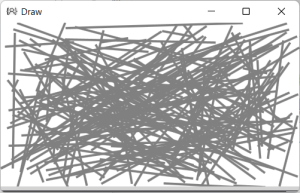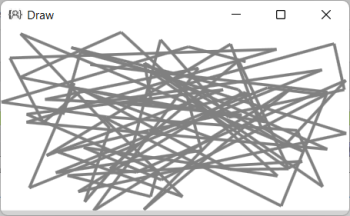Continuous lines
with functions
Draw 200 lines on the canvas. Find x and y coordinates using the random function. The maximum value for the x-coordinate is width() and for the y-coordinate height(). Set the width of the stroke to 3 and the color to 128.


for..., random, background, line, stroke, strokeWeight
background(255)
strokeWeight(3)
stroke(128)
for i in range(0, 200):
x1 = random(0, width())
y1 = random(0, height())
x2 = random(0, width())
y2 = random(0, height())
line(x1, y1, x2, y2)
Change exercise 1 so that the end of the line is the beginning of the next line, resulting in a continuous line.


for..., random, background, line, stroke, strokeWeight
background(255)
strokeWeight(3)
stroke(128)
x1 = random(0, width())
y1 = random(0, height())
for i in range(0, 80):
x2 = random(0, width())
y2 = random(0, height())
line(x1, y1, x2, y2)
x1 = x2
y1 = y2
Change exercise 2 so that it doesn't use a for-loop. Instead, you use the timer function to set a draw function and draw a single line with each call.
timer, random, background, line, stroke, strokeWeight
background(255)
strokeWeight(3)
stroke(128)
x1 = random(0, width())
y1 = random(0, height())
def draw():
global x1, y1
x2 = random(0, width())
y2 = random(0, height())
line(x1, y1, x2, y2)
x1 = x2
y1 = y2
timer(draw)